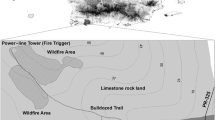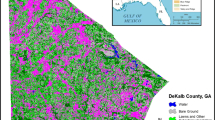Abstract
One of the last primitive island ecosystems in the Indian Ocean has been invaded since 1969 by the Sri Lankan privet, Ligustrum robustum. L. robustum is still spreading in the forests of La Réunion Island, where only 30% of the original vegetation remains, but where 98% of the primary native vegetation of the Mascarene Islands still exists. On Mauritius, where L. robustum was introduced about 1895, it now forms dense, impenetrable thickets, and its presence has been correlated with the inability of native vegetation to re-establish. We assessed the potential impacts of L. robustum invasion on the native ecosystems of La Réunion and identified the factors of invasibility. We determined the degree of invasion in 12 plots of 156 m2 and followed native flora and privet recruitment for 3 years in 12 seedling plots of 39 m2. The data show that monocultural L. robustum stands now exist in human-disturbed primary forest patches (3.3 individuals/m2 and 80% of total individuals) and high seedling densities (0.3–0.6/m2) occur in the least disturbed patches. L. robustum's rapid growth, high shade tolerance and seed production, bird-assisted seed dispersal and high seedling recruitment contribute to its invasiveness in intact forests. The conservation of the original ecosystems of La Réunion depends on the setting up of a long-term and immediate global control strategy.
Similar content being viewed by others
References
Badré F and Cadet T (1978) The Pteridophytes of Réunion Island. Fern Gazette 11: 349–365
Barré N, Barau A and Jouanin C (1996) Oiseaux de La Réunion. Les Editions Du Pacifique, Paris, 207 pp
Berglund JV (1976) Silvics. State University of New York, College of Environmental Science and Forestry, Syracuse, 448 pp
Besnard N, Le Corre M and Barré S (1996) Le Bulbul Orphée à La Réunion: répartition, habitats et abondance en juillet-août 1996. Technical report, Natural History Museum, Saint-Denis, La Réunion, France, 17 pp
Bhupal Rao JVR and Divakar NG (1981) Heterostyly in Jasminum auriculatum Vahl. Incompatibility Newsletter 13: 17–19
Blossey B and Kamil J (1996) What determines the increased competitive ability of invasive non-indigenous plants? In: Moran VC and Hoffmann JH (eds) Proceedings of the IX International Symposium on Biological Control of Weeds, Stellenbosch, South Africa, 19–26 January 1996, pp 3–9.
Bosser J, Cadet T, Guého J, Julien HR and Marais W (1976-ongoing) Flore des Mascareignes: Réunion, Maurice, Rodrigues. MSIRI, Mauritius, ORSTOM, Paris and Royal Botanical Garden, Kew, UK
Bradley MV and Griggs WH (1963) Morphological evidence of incompatibility in Olea europaea L. Phytomorphology 13: 141–156
Brouard NR (1963) A history of Woods and Forests in Mauritius. Government Printer, Port-Louis, Mauritius, 86 pp
Cadet J and Bosser J (1989) Joyaux de nos forêts: les orchidées de La Réunion. Nouvelle Imprimerie Dionysienne, Saint-Denis, La Réunion, France, 175 pp
Cadet T (1977) La végétation de l'Ile de La Réunion: étude phytoécologique et phytosociologique. Thése d'Etat, University of Aix-Marseille, France, 362 pp
Chandran K and Shah FA (1974) Beekeping in Kadai Hills (Tamilnadu). Indian Bee Journal 36: 1–8
Cheke AS (1987) An ecological history of the Mascarene Islands, with particular reference to extinctions and introductions of vertebrates. In: Diamond AW (ed) Studies of Mascarene Island Birds, pp 5–89. Cambridge University Press, Cambridge, England, UK
Crawley MJ (1987) What makes a community invasible? In: Gray AJ, Crawley MJ and Edwards PJ (eds) Colonization, Succession and Stability, pp 429–453. Blackwell Scientific Publications, Oxford, UK
D'Antonio CM and Dudley TL (1995) Biological invasions as agents of change on islands versus mainlands. In: Vitousek PM, Loope LL and Adsersen H (eds) Islands, Biological Diversity and Ecosystem Function, pp 103–121. Springer-Verlag, Berlin
Dommé B, Thompson JD and Cristini F (1992) Distylie chez Jasminum fruticans L.: hypothèse de la pollinisation optimale basée sur les variations de l'écologie intra-florale. Bulletin de la Société Botanique de France 139: 223–234
Dulloo E (1996) The flora and conservation potential of offshore islets around Rodrigues, Indian Ocean. Proceedings of the Royal Society of Arts and Sciences of Mauritius 6: 13–36
Dupont J (1980–1991) Inventaire des Zones Naturelles d'Intérêts Ecologiques, Faunistiques et Floristiques (IZNIEFF). Inventories Zone I No 0001 0003, 0001 0004, 0001 0005, 0001 0085, 0001 0086, 0001 0088 and 0001 0089, Secrétariat Faune-Flore, Ministère de l'Environnement, Paris
Dupont J (1990) Cartes de végétation de La Réunion. Document, Société Réunionnaise pour l'Etude et la Protection de l'Environnement, Saint-Denis, La Réunion, 21 colour plates
Dupont J and Girard J-C (1988) La végétation naturelle du Cirque de Cilaos: justifications scientifiques du projet de Réserve Biologique Domaniale et proposition des limites. Scientific report, Société Réunionnaise pour l'Etude et la Protection de l'Environnement, Saint-Denis, La Réunion, France, 14 pp
Dupont J, Girard J-C and Guinet M (1989) Flore en détresse. Nouvelle Imprimerie Dionysienne, Saint-Denis, La Réunion, France, 133 pp
Fleishmann K (1997) Invasion of alien woody plants on the island of Mahé and Silhouette. Journal of Vegetation Sciences 8: 5–12
Florence J (1987) Endémisme et évolution de la flore de la Polynésie française. Bulletin de la Société Zoologique de France 112: 369–380
Gamble JS (1957). Flora of the Presidency of Madras, Vol 2, pp 559–561. West Newman & Adlard, Calcutta, India
Green PS (1985) Ligustrum robustum subsp. walkeri (Oleaceae). Kew Bulletin 40: 130
Green PS (1987) Oleaceae. In: Dassanayake MD and Fosberg FR (eds) A revised handbook to the Flora of Ceylon Vol. 6, pp 270–271. Amerind Publishing Co., New Delhi
Green PS (1990) Ligustrum (Oleaceae) in Southern India. Kew Bulletin 45: 693–696
Grime JP (1979) Plant strategies and vegetation processes, John Wiley & Sons, Chichester, UK, 222 pp
Groves RH (1986) Plant invasions of Australia: an overview. In: Groves RH and Burdon JJ (eds) Ecology of Biological Invasions, pp 137–149. Cambridge University Press, Canberra, Australia
Hariot P (1898) Plantes nouvelles ou peu connues, Ligustrum insulare Decsn. et Ligustrum walkeri Decsn. Le Jardin: 28
Hooker JD (1882). Oleaceae. In: Reeve L (ed) Flora of British India, Vol 3, pp 614–615. London
Institut Géographique National (1990) Carte générale de l'Ile Maurice. Scale 1/100 000. IGN, Paris
Indian Ocean Plant Specialist Group (1999) Plant Red List for La Réunion Island. Conservatoire Botanique National de Mascarin, La Réunion
LaRosa AM, Smith CW and Gardner DE (1985) Role of alien and native birds in the dissemination of firetree (Myrica faya Ait. — Myricaceae) and associated plants in Hawaii. Pacific Science 39: 372–378
Lorence D-H and Sussman RW (1986) Exotic species invasion into Mauritius wet forest remnants. Journal of Tropical Ecology 2: 147–162
Lorence D-H and Sussman RW (1988) Diversity, density, and invasion in a Mauritian wet forest. Monographs of the Systematics of the Missouri Botanical Garden 25: 187–204
Lavergne C and Sigala P (1996) Environmental weeds in native forests of La Réunion Islands: prospects for biocontrol. In: Moran VC and Hoffmann JH (eds) Proceedings of the IX International Symposium on Biological Control of Weeds, Stellenbosch, South Africa, 19–26 January 1996, pp 339 (Abstract)
Lavergne R (1978) Les pestes végétales de l'Ile de La Réunion. Info-Nature 16: 9–60
Lawesson JE (1990) Alien plants in the Galápagos islands, a summary. Monographs of the Systematics of the Missouri Botanical Garden 32: 15–20
Loope LL, Hamman O and Stone CP (1988) Comparative conservation biology of oceanic archipelagos, Hawaii and the Galápagos. BioScience 38: 272–282.
MacDonald IAW (1989) Stratégie de recherche et de gestion pour le contrôle à long-terme des pestes végétales à La Réunion. Technical report, Conseil Régional, Saint-Denis, La Réunion, France, 22 pp
MacDonald IAW, Ortiz L, Lawesson JE and Nowak JB (1988) The invasion of highlands in Galapagos by the Red Quinine-tree Cinchona succirubra. Environmental Conservation 15: 215–220
MacDonald IAW, Thébaud C, Strahm WA and Strasberg D (1991) Effects of Alien Plant Invasions on Native Vegetation Remnants on La Reunion (Mascarene Islands, Indian Ocean). Environmental Conservation 18: 51–61
Mauritian Wildlife Foundation (1997) UNDP/GEF project restoration of highly degraded native forest in Mauritius. Biodiversity Assessment Technical Report, MWF, Mauritius, 26 pp
Meyer J-Y (1994) Mécanisme d'invasion de Miconia calvescens DC. en Polynésie Française. PhD thesis. University of Montpellier II, 126 pp
Meyer J-Y and Florence J (1996) Tahiti's native flora endangered by the invasion of Miconia calvescens DC. (Melastomataceae). Journal of Biogeography 23: 775–781
Meyer J-Y and Malet J-P (1997) Study and management of an alien invasive tree Miconia calvescens DC. (Melastomataceae) in the islands of Raiatea and Tahaa (Society Islands, French Polynesia): 1992–1996. Technical Report No 111, Cooperative National Park Resources Studies Unit Hawaii, University of Hawaii at Manoa, Honolulu, Hawaii, 56 pp
Mungroo Y and Tezoo V (1999) Control of alien invasive species in Mauritius. In: Invasive Species in Eastern Africa Workshop [on-line version]. International Centre for Insect Physiology and Ecology (ICIPE) Campus, Nairobi, Kenya, 5–6 July 1999, 5 pp, URL: http://www.icipe.org/webdata/biodiversity/invasiveWorkshop/talks/mauritius.cfm
Ramakrishnan PS (1991) Biological invasion in the tropics: an overview. In: Ramakrishnan PS (ed) Ecology of Biological Invasion in the Tropics, pp 1–19. International Scientific Publications, New Delhi
Rejmánek M and Richardson DM (1996) What attributes make some plant species more invasive? Ecology 77: 1655–1661
Rouillard G and Guého J (1990) Le jardin botanique de Curepipe. Curepipe Municipality, Mauritius, 49 pp
Rouillard G and Guého J (1994) Histoire des plantes d'intérêt horticole, médicinal et économique à l'Ile Maurice. Revue Agricole et Sucrière de l'Ile Maurice 73: 75–101
Sale GN (1935) Exotics in Mauritius. In: Proceedings of British Empire Forestry Conference, South Africa, 3–12 pp
Shaw RH and Milne R (1999) The use of molecular techniques in the classical biological control programme against an invasive Ligustrum species in La Réunon. In: the Program Abstracts of the X International Symposium on Biological Control of Weeds, Montana State University, Bozeman, Montana, USA, 4–14 July 1999, pp 85
Smith CW (1989) Non-Native Plants. In: Stone CP and DB (eds) Conservation Biology in Hawaii, pp 60–68. Cooperative National Park Resources Studies Unit, University of Hawaii at Manoa, University of Hawaii Press, Honolulu, Hawaii
Strahm WA (1983) Rodrigues: can its flora be saved? Oryx 17(3): 122–125
Strahm WA (1988) The Mondrain Reserve and its conservation management. Proceedings of the Royal Society of Arts and Sciences, Mauritius 5: 139–177
Strahm WA (1989) Plant Red Data Book for Rodrigues. IUCN-WWF, Koeltz Scientific Books, Koningstein, Germany
Strahm WA (1994) The Conservation and restoration of the flora of Mauritius and Rodrigues. PhD thesis. University of Reading, UK
Strasberg D (1994) Dynamique des forêts tropicales de l'île de La Réunion, processus d'invasion et de régénération sur les coulées volcaniques. PhD thesis. University of Montpellier II, France, 178 pp
Strasberg D (1995) Processus d'invasion par les plantes introduites à La Réunion et dynamique de la végétation sur les coulées volcaniques. Ecologie 26: 169–180
Thébaud C (1989) Contribution à l'étude des plantes étrangères envahissantes à l'Ile de La Réunion. Technical report, Office National des Forêts, Saint-Denis, La Réunion, France, 49 pp
Thébaud C and Strasberg D (1997) Plant dispersal in fragmented landscapes: a field study of woody colonization in rainforest remnants of the Mascarene Archipelago. In: Laurence WF, Bierregaard R and Moritz C (eds) Tropical Forest Remnants: Ecology, Conservation and Management, pp 321–332. University of Chicago Press, Chicago, Illinois
Tirvengadum DD (1983) L'exemple de l'Ile Rodrigues (Mascareignes): destruction d'une flore insulaire. Compt. Rend. Sommaire Séances Société Biogéographie 59: 213–222
Vaughan RE and Wiehe PO (1937) Studies on the vegetation of Mauritius. I. A preliminary survey of the plant communities. Journal of Ecology 25: 289–343
Wagner WL, Herbst DR and Sohmer SH (1990) Manual of the Flowering plants of Hawaii Vol. 1. University of Hawaii Press and Bishop Museum Press, Honolulu, Hawaii
Whiteaker LD and Gardner DE (1985) The distribution of Myrica faya Ait in the state of Hawaii. Technical report No 55, Cooperative National Park Resources Studies Unit, University of Hawaii at Manoa, University of Hawaii Press, Honolulu, Hawaii, 31 pp
Author information
Authors and Affiliations
Corresponding author
Rights and permissions
About this article
Cite this article
Lavergne, C., Rameau, JC. & Figier, J. The Invasive Woody Weed Ligustrum robustum subsp. walkeri Threatens Native Forests on La Réunion. Biological Invasions 1, 377–392 (1999). https://doi.org/10.1023/A:1010001529227
Issue Date:
DOI: https://doi.org/10.1023/A:1010001529227




